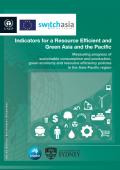When compared to other regions, Asia has the highest rate of policy innovations that can help in the transition to a green economy. Even though fiscal instruments in-use are to some extent already altering aggregate demand of resources and economic activities, resource allocation, and distributive capacity of the economy, instrument such as “carbon tax” that has the real potential to contain rising emissions and save economies from getting locked into carbon-intensive pathways are yet to be adopted widely. Sporadic adoption of fiscal instruments is not going to be enough, if Asia as a region, is to transition to a green economy. In addition, there are substantial implementation barriers that need to be eased for wide-scale adoption and diffusion of green fiscal instruments.
This publication provides an opportunity for Asia and the Pacific policymakers and stakeholders, such as those from the private sector, academia and civil society organizations, to actively engage with the global negotiations, and to lay out the financing and partnership frameworks for the development agenda beyond 2015 from the regional perspectives.
The publication calls for the Asia-Pacific region to work together to raise and channel more substantial financial resources to invest in the social sector, infrastructure development and efforts to tackle climate change in order to ensure a transformative change to bring about inclusive growth and sustainable development.
Although there is progress in developing green sectors in North America and East Asia, the key challenge facing the expansion of economy-wide green innovation and structural change in these regions is the absence of relevant policy follow-up to the green stimulus enacted during the Great Recession. The boost to green sectors provided by such measures is waning quickly, given that much of the green stimulus focused on energy efficiency.
The biggest obstacles to sustaining green growth in North America and East Asiaare major market disincentives, especially the under-pricing of fossil fuels and market failures that inhibit green innovation. A three-part strategy to overcome these obstacles would involve: first, removing fossil fuel subsidies; second, employing market-based instruments to further reduce the social costs of fossil fuel use; and third, allocating any resulting revenue to public support for green innovation and investments. Such a strategy would ensure that green growth is not about promoting niche green sectors but instigating economy-wide innovation and structural transformation in North America and East Asia.
Adequate, appropriate finance is crucial for sustainable development in the Asia-Pacific region. The United Nations Economic and Social Commission for Asia and the Pacific UN (ESCAP) estimates that the region needs to invest around US$2.5 trillion a year between 2013 and 2030 to achieve key sustainable development goals:
- US$500-800 billion to close gaps in education, health, employment, social protection and basic access to energy services.
- US$800-$900 billion for developing infrastructure for energy, transport, telecommunications and water and sanitation.
- US$500-800 billion for climate change mitigation and renewable energy.
This briefing has been produced by the UNEP Inquiry as a contribution to discussions at the Regional Consultation on Financing for Development in Asia and the Pacific which took place in Jakarta, Indonesia in April 2015. It draws on the Inquiry’s ongoing research, and country engagement in particularly focusing on the sustainable development, financial systems and actions to be conducted for the Asia and the Pacific region.

Natural resources are the foundation of economic development. This report reveals the patterns and the evolution of natural resource use with 118 indicators in 26 countries of the Asia and the Pacific region over the last 40 years. The analysis shows that resource use in the region is both inefficient and unsustainable. The Asia-Pacific region will not be able to base its future economic growth on declining costs of natural resources as was possible during most of the twentieth century. An increasing reliance on resources from abroad and volatility in the global resource markets will pose challenges to the economic resilience of countries in the region. In this new economic context resource efficiency and decoupling of economic growth and resource use will be fundamental to the economic success of the region. The knowledge generated by this report helps to improve the understanding of the natural resource use and emissions consequences of economic growth in Asia and the Pacific to support policy formulation, monitoring and policy evaluation in the countries of the region.
